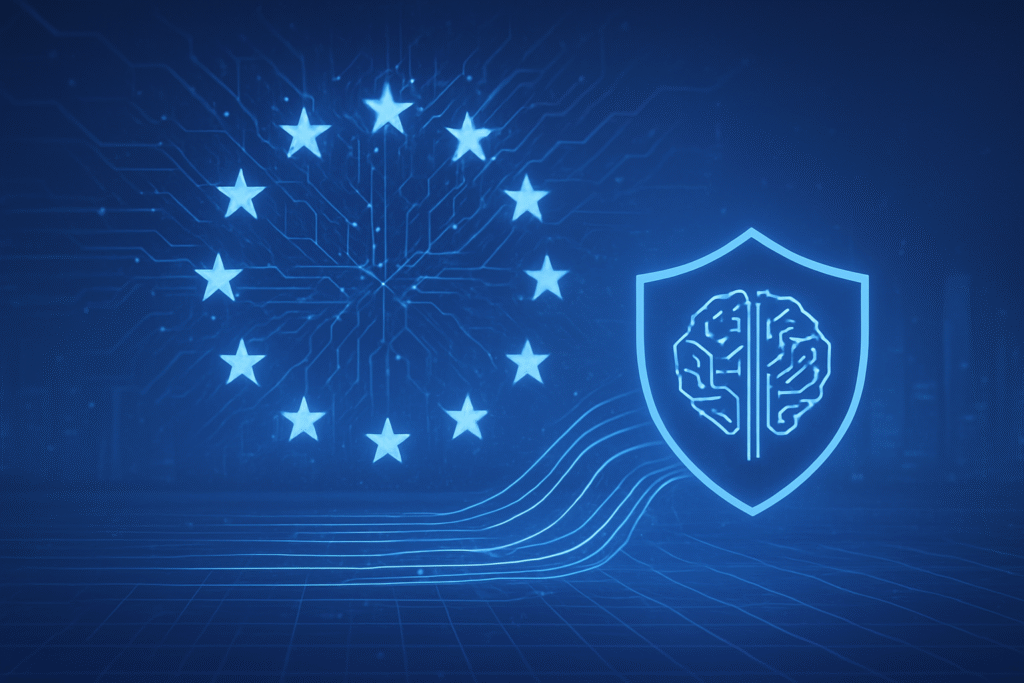
Brussels, Belgium – November 5, 2025 – The European Union has officially ushered in a new era of artificial intelligence governance with the staggered implementation of its landmark AI Act, the world's first comprehensive legal framework for AI. With key provisions already in effect and full applicability looming by August 2026, this pioneering legislation is poised to profoundly reshape how AI systems are developed, deployed, and governed across Europe and potentially worldwide. The Act’s human-centric, risk-based approach aims to foster trustworthy AI, safeguard fundamental rights, and ensure transparency and accountability, setting a global precedent akin to the EU’s influential GDPR.
This ambitious regulatory undertaking comes at a critical juncture, as AI technologies continue their rapid advancement, permeating every facet of society. The EU AI Act is designed to strike a delicate balance: fostering innovation while mitigating the inherent risks associated with increasingly powerful and autonomous AI systems. Its immediate significance lies in establishing clear legal boundaries and responsibilities, offering a much-needed framework for ethical AI development in a landscape previously dominated by voluntary guidelines.
A Technical Deep Dive into Europe's AI Regulatory Framework
The EU AI Act, formally known as Regulation (EU) 2024/1689, employs a nuanced, four-tiered risk-based approach, categorizing AI systems based on their potential to cause harm. This framework is a significant departure from previous non-binding guidelines, establishing legally enforceable requirements across the AI lifecycle. The Act officially entered into force on August 1, 2024, with various provisions becoming applicable in stages. Prohibitions on unacceptable risks and AI literacy obligations took effect on February 2, 2025, while governance rules and obligations for General-Purpose AI (GPAI) models became applicable on August 2, 2025. The majority of the Act's provisions, particularly for high-risk AI, will be fully applicable by August 2, 2026.
At the highest tier, unacceptable risk AI systems are outright banned. These include AI for social scoring, manipulative AI exploiting human vulnerabilities, real-time remote biometric identification in public spaces (with very limited law enforcement exceptions), biometric categorization based on sensitive characteristics, and emotion recognition in workplaces and educational institutions. These prohibitions reflect the EU's strong stance against AI applications that fundamentally undermine human dignity and rights.
The high-risk category is where the most stringent obligations apply. AI systems are classified as high-risk if they are safety components of products covered by EU harmonization legislation (e.g., medical devices, aviation) or if they are used in sensitive areas listed in Annex III. These areas include critical infrastructure, education and vocational training, employment and worker management, law enforcement, migration and border control, and the administration of justice. Providers of high-risk AI must implement robust risk management systems, ensure high-quality training data to minimize bias, maintain detailed technical documentation and logging, provide clear instructions for use, enable human oversight, and guarantee technical robustness, accuracy, and cybersecurity. They must also undergo conformity assessments and register their systems in a publicly accessible EU database.
A crucial evolution during the Act's drafting was the inclusion of General-Purpose AI (GPAI) models, often referred to as foundation models or large language models (LLMs). All GPAI model providers must maintain technical documentation, provide information to downstream developers, establish a policy for compliance with EU copyright law, and publish summaries of copyrighted data used for training. GPAI models deemed to pose a "systemic risk" (e.g., those trained with over 10^25 FLOPs) face additional obligations, including conducting model evaluations, adversarial testing, mitigating systemic risks, and reporting serious incidents to the newly established European AI Office. Limited-risk AI systems, such as chatbots or deepfakes, primarily require transparency, meaning users must be informed they are interacting with an AI or that content is AI-generated. The vast majority of AI systems fall into the minimal or no risk category, facing no additional requirements beyond existing legislation.
Initial reactions from the AI research community and industry experts have been mixed. While widely lauded for setting a global standard for ethical AI and promoting transparency, concerns persist regarding potential overregulation and its impact on innovation, particularly for European startups and SMEs. Critics also point to the complexity of compliance, potential overlaps with other EU digital legislation (like GDPR), and the challenge of keeping pace with rapid technological advancements. However, proponents argue that clear guidelines will ultimately foster trust, drive responsible innovation, and create a competitive advantage for companies committed to ethical AI.
Navigating the New Landscape: Impact on AI Companies
The EU AI Act presents a complex tapestry of challenges and opportunities for AI companies, from established tech giants to nascent startups, both within and outside the EU due to its extraterritorial reach. The Act’s stringent compliance requirements, particularly for high-risk AI systems, necessitate significant investment in legal, technical, and operational adjustments. Non-compliance can result in substantial administrative fines, mirroring the GDPR's punitive measures, with penalties reaching up to €35 million or 7% of a company's global annual turnover for the most severe infringements.
Tech giants like Alphabet (NASDAQ: GOOGL), Microsoft (NASDAQ: MSFT), and Amazon (NASDAQ: AMZN), with their extensive resources and existing "Responsible AI" initiatives, are generally better positioned to absorb the substantial compliance costs. Many have already begun adapting their internal processes and dedicating cross-functional teams to meet the Act's demands. Their capacity for early investment in compliant AI systems could provide a first-mover advantage, allowing them to differentiate their offerings as inherently trustworthy and secure. However, they will still face the immense task of auditing and potentially redesigning vast portfolios of AI products and services.
For startups and Small and Medium-sized Enterprises (SMEs), the Act poses a more significant hurdle. Estimates suggest annual compliance costs for a single high-risk AI model could be substantial, a burden that can be prohibitive for smaller entities. This could potentially stifle innovation in Europe, leading some startups to consider relocating or focusing on less regulated AI applications. However, the Act includes provisions aimed at easing the burden on SMEs, such as tailored quality management system requirements and simplified documentation. Furthermore, the establishment of regulatory sandboxes offers a crucial avenue for startups to test innovative AI systems under regulatory guidance, fostering compliant development.
Companies specializing in AI governance, explainability, risk management, bias detection, and cybersecurity solutions are poised to benefit significantly. The demand for tools and services that help organizations achieve and demonstrate compliance will surge. Established European companies with strong compliance track records, such as SAP (XTRA: SAP) and Siemens (XTRA: SIE), could also leverage their expertise to develop and deploy regulatory-driven AI solutions, gaining a competitive edge. Ultimately, businesses that proactively embrace and integrate ethical AI practices into their core operations will build greater consumer trust and loyalty, turning compliance into a strategic advantage.
The Act will undoubtedly disrupt certain existing AI products and services. AI systems falling into the "unacceptable risk" category, such as social scoring or manipulative AI, are explicitly banned and must be withdrawn from the EU market. High-risk AI applications will require substantial redesigns, rigorous testing, and ongoing monitoring, potentially delaying time-to-market. Providers of generative AI will need to adhere to transparency requirements, potentially leading to widespread use of watermarking for AI-generated content and greater clarity on training data. The competitive landscape will likely see increased barriers to entry for smaller players, potentially consolidating market power among larger tech firms capable of navigating the complex regulatory environment. However, for those who adapt, compliance can become a powerful market differentiator, positioning them as leaders in a globally regulated AI market.
The Broader Canvas: Societal and Global Implications
The EU AI Act is more than just a piece of legislation; it is a foundational statement about the role of AI in society and a significant milestone in global AI governance. Its primary significance lies not in a technological breakthrough, but in its pioneering effort to establish a comprehensive legal framework for AI, positioning Europe as a global standard-setter. This "Brussels Effect" could see its principles adopted by companies worldwide seeking access to the lucrative EU market, influencing AI regulation far beyond European borders, much like the GDPR did for data privacy.
The Act’s human-centric and ethical approach is a core tenet, aiming to protect fundamental rights, democracy, and the rule of law. By explicitly banning harmful AI practices and imposing strict requirements on high-risk systems, it seeks to prevent societal harms, discrimination, and the erosion of individual freedoms. The emphasis on transparency, accountability, and human oversight for critical AI applications reflects a proactive stance against the potential dystopian outcomes often associated with unchecked AI development. Furthermore, the Act's focus on data quality and governance, particularly to minimize discriminatory outcomes, is crucial for fostering fair and equitable AI systems. It also empowers citizens with the right to complain about AI systems and receive explanations for AI-driven decisions, enhancing democratic control over technology.
Beyond business concerns, the Act raises broader questions about innovation and competitiveness. Critics argue that the stringent regulatory burden could stifle the rapid pace of AI research and development in Europe, potentially widening the investment gap with regions like the US and China, which currently favor less prescriptive regulatory approaches. There are concerns that European companies might struggle to keep pace with global technological advancements if burdened by excessive compliance costs and bureaucratic delays. The Act's complexity and potential overlaps with other existing EU legislation also present a challenge for coherent implementation, demanding careful alignment to avoid regulatory fragmentation.
Compared to previous AI milestones, such as the invention of neural networks or the development of powerful large language models, the EU AI Act represents a regulatory milestone rather than a technological one. It signifies a global paradigm shift from purely technological pursuit to a more cautious, ethical, and governance-focused approach to AI. This legislative response is a direct consequence of growing societal awareness regarding AI's profound ethical dilemmas and potential for widespread societal impact. By addressing specific modern developments like general-purpose AI models, the Act demonstrates its ambition to create a future-proof framework that can adapt to the rapid evolution of AI technology.
The Road Ahead: Future Developments and Expert Predictions
The full impact of the EU AI Act will unfold over the coming years, with a phased implementation schedule dictating the pace of change. In the near-term, by August 2, 2026, the majority of the Act's provisions, particularly those pertaining to high-risk AI systems, will become fully applicable. This period will see a significant push for companies to audit, adapt, and certify their AI products and services for compliance. The European AI Office, established within the European Commission, will play a pivotal role in monitoring GPAI models, developing assessment tools, and issuing codes of good practice, which are expected to provide crucial guidance for industry.
Looking further ahead, an extended transition period for high-risk AI systems embedded in regulated products extends until August 2, 2027. Beyond this, from 2028 onwards, the European Commission will conduct systematic evaluations of the Act's functioning, ensuring its adaptability to rapid technological advancements. This ongoing review process underscores the dynamic nature of AI regulation, acknowledging that the framework will need continuous refinement to remain relevant and effective.
The Act will profoundly influence the development and deployment of various AI applications and use cases. Prohibited systems, such as those for social scoring or manipulative behavioral prediction, will cease to exist within the EU. High-risk applications in critical sectors like healthcare (e.g., AI for medical diagnosis), financial services (e.g., credit scoring), and employment (e.g., recruitment tools) will undergo rigorous scrutiny, leading to more transparent, accountable, and human-supervised systems. Generative AI, like ChatGPT, will need to adhere to transparency requirements, potentially leading to widespread use of watermarking for AI-generated content and greater clarity on training data. The Act aims to foster a market for safe and ethical AI, encouraging innovation within defined boundaries.
However, several challenges need to be addressed. The significant compliance burden and associated costs, particularly for SMEs, remain a concern. Regulatory uncertainty and complexity, especially in novel cases, will require clarification through guidance and potentially legal precedents. The tension between fostering innovation and imposing strict regulations will be an ongoing balancing act for EU policymakers. Furthermore, the success of the Act hinges on the enforcement capacity and technical expertise of national authorities and the European AI Office, which will need to attract and retain highly skilled professionals.
Experts widely predict that the EU AI Act will solidify its position as a global standard-setter, influencing AI regulations in other jurisdictions through the "Brussels Effect." This will drive an increased demand for AI governance expertise, fostering a new class of professionals with hybrid legal and technical skillsets. The Act is expected to accelerate the adoption of responsible AI practices, with organizations increasingly embedding ethical considerations and compliance deep into their development pipelines. Companies are advised to proactively review their AI strategies, invest in robust responsible AI programs, and consider leveraging their adherence to the Act as a competitive advantage, potentially branding themselves as providers of "Powered by EU AI solutions." While the Act presents significant challenges, it promises to usher in an era where AI development is guided by principles of trust, safety, and fundamental rights, shaping a more ethical and accountable future for artificial intelligence.
This content is intended for informational purposes only and represents analysis of current AI developments.
TokenRing AI delivers enterprise-grade solutions for multi-agent AI workflow orchestration, AI-powered development tools, and seamless remote collaboration platforms.
For more information, visit https://www.tokenring.ai/.







